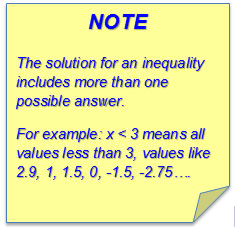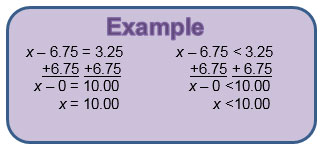In the last section, you wrote inequality statements using variables, operations, and numbers. You correctly matched inequalities to one of four problem situations. Now, you are going to solve those inequalities and check for reasonable solutions.
![]() Click on the problem below for the solution.
Click on the problem below for the solution.
Use the interactive to answer the following questions.
Interactive popup. Assistance may be required.
The inequality above, 23 ≥ x, states x has to be less than or equal to 23.

Interactive popup. Assistance may be required.
The inequality for the number of hot dogs per minute is x = 61 over 10 61 10 . If Tim ate more than 61 over 10 61 10 hot dogs per minute, he would tie or beat the record.
In solving the inequalities above, you either had to subtract or divide by a positive number, similar to solving equations.

![]() There is one exception that makes solving inequalities different from solving equations. When you multiply or divide by a negative number, there is an additional step you must take. Watch the video below to learn more about multiplying or dividing by a negative number when solving inequalities.
There is one exception that makes solving inequalities different from solving equations. When you multiply or divide by a negative number, there is an additional step you must take. Watch the video below to learn more about multiplying or dividing by a negative number when solving inequalities.
Source: Inequalities- Multiplying/Dividing, Textbook Tactics, You Tube
Use the information presented in the video to solve the following inequalities. Watch the video again if you need assistance.
Interactive popup. Assistance may be required.
Solve the inequality like an equation, except that since the coefficient is -5, the inequality sign needs to be reversed. Since -5 is multiplied by a, divide both sides by -5.
Interactive popup. Assistance may be required.
Solve the inequality like an equation, except that since the coefficient is -6, the inequality sign needs to be reversed. Since -6 is multiplied by b, divide both sides by -6.
Interactive popup. Assistance may be required.
Solve the inequality like an equation, except that since the coefficient is -1 over 2 1 2 , the inequality sign needs to be reversed. Since c is being divided by -2, multiply both sides by -2.
![]() Helium has a boiling point of -2688 over 9
8
9
°C. If negative nine-fifths of the temperature (in degrees Celsius) is less than 484, the helium will turn into a gas. Write an inequality by dragging the tiles to the appropriate place to create an inequality.
Helium has a boiling point of -2688 over 9
8
9
°C. If negative nine-fifths of the temperature (in degrees Celsius) is less than 484, the helium will turn into a gas. Write an inequality by dragging the tiles to the appropriate place to create an inequality.
Use the inequality from the interactive to answer the following questions.
Interactive popup. Assistance may be required.
The first step would be to change the coefficient to 1, the identity.
Interactive popup. Assistance may be required.
Since the multiplier is negative, reverse the inequality symbol when multiplying both sides by the reciprocal.
Interactive popup. Assistance may be required.
Is -1210 over 3 -1210 3 °C > -2420 over 9 -2420 9 °C?
Interactive popup. Assistance may be required.
The gas tank holds 10 gallons of gasoline or less.
Interactive popup. Assistance may be required.
The element’s melting point is at least 140.1°C more than mercury’s melting point. What operation does this suggest? What inequality symbol does “at least” suggest?
Interactive popup. Assistance may be required.
Determine how to make the coefficient 1, which is the multiplicative identity. Remember when multiplying or dividing by a negative number, the inequality sign reverses.